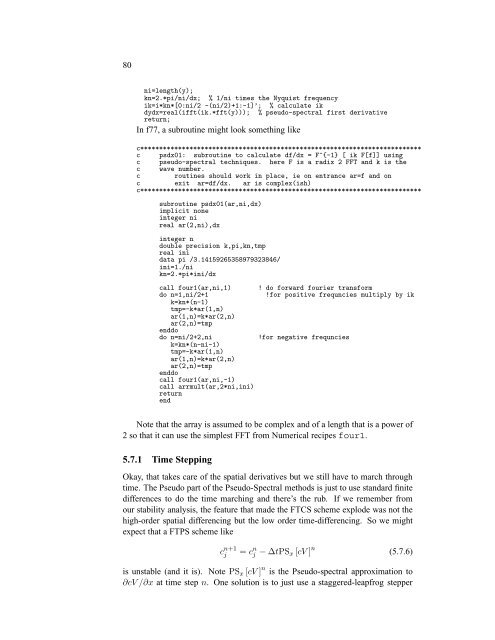Transport: Non-diffusive, flux conservative initial value problems and ...
Transport: Non-diffusive, flux conservative initial value problems and ...
Transport: Non-diffusive, flux conservative initial value problems and ...
Create successful ePaper yourself
Turn your PDF publications into a flip-book with our unique Google optimized e-Paper software.
80<br />
ni=length(y);<br />
kn=2.*pi/ni/dx; % 1/ni times the Nyquist frequency<br />
ik=i*kn*[0:ni/2 -(ni/2)+1:-1]’; % calculate ik<br />
dydx=real(ifft(ik.*fft(y))); % pseudo-spectral first derivative<br />
return;<br />
In f77, a subroutine might look something like<br />
c**************************************************************************<br />
c psdx01: subroutine to calculate df/dx = F^{-1} [ ik F[f]] using<br />
c pseudo-spectral techniques. here F is a radix 2 FFT <strong>and</strong> k is the<br />
c wave number.<br />
c routines should work in place, ie on entrance ar=f <strong>and</strong> on<br />
c exit ar=df/dx. ar is complex(ish)<br />
c**************************************************************************<br />
subroutine psdx01(ar,ni,dx)<br />
implicit none<br />
integer ni<br />
real ar(2,ni),dx<br />
integer n<br />
double precision k,pi,kn,tmp<br />
real ini<br />
data pi /3.14159265358979323846/<br />
ini=1./ni<br />
kn=2.*pi*ini/dx<br />
call four1(ar,ni,1) ! do forward fourier transform<br />
do n=1,ni/2+1 !for positive frequncies multiply by ik<br />
k=kn*(n-1)<br />
tmp=-k*ar(1,n)<br />
ar(1,n)=k*ar(2,n)<br />
ar(2,n)=tmp<br />
enddo<br />
do n=ni/2+2,ni !for negative frequncies<br />
k=kn*(n-ni-1)<br />
tmp=-k*ar(1,n)<br />
ar(1,n)=k*ar(2,n)<br />
ar(2,n)=tmp<br />
enddo<br />
call four1(ar,ni,-1)<br />
call arrmult(ar,2*ni,ini)<br />
return<br />
end<br />
Note that the array is assumed to be complex <strong>and</strong> of a length that is a power of<br />
2 so that it can use the simplest FFT from Numerical recipes four1.<br />
5.7.1 Time Stepping<br />
Okay, that takes care of the spatial derivatives but we still have to march through<br />
time. The Pseudo part of the Pseudo-Spectral methods is just to use st<strong>and</strong>ard finite<br />
differences to do the time marching <strong>and</strong> there’s the rub. If we remember from<br />
our stability analysis, the feature that made the FTCS scheme explode was not the<br />
high-order spatial differencing but the low order time-differencing. So we might<br />
expect that a FTPS scheme like<br />
c n+1<br />
j<br />
= cn j − ∆tPSx [cV ] n<br />
(5.7.6)<br />
is unstable (<strong>and</strong> it is). Note PSx [cV ] n is the Pseudo-spectral approximation to<br />
∂cV /∂x at time step n. One solution is to just use a staggered-leapfrog stepper

















